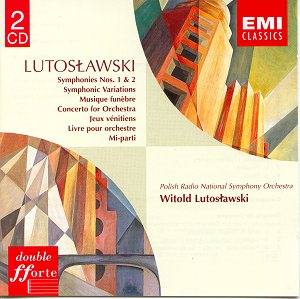Witold LUTOSLAWSKI
Symphonic Variations Concerto for Orchestra
Symphony No. 1 Jeux venitiens
Musique funebre Livre pour orchestre
Symphony No. 2 Mi
parti
 Polish Radio National Symphony
Orchestra - Witold Lutoslawski
Polish Radio National Symphony
Orchestra - Witold Lutoslawski
recorded at Polish Radio & TV Studios, Katowice,a co-production with
EMI and Polish Radio and TV May and June, 1976, and December
1977.
 EMI Double Forte CZS5
73833-2 - 2 discs - ADD - Stereo
EMI Double Forte CZS5
73833-2 - 2 discs - ADD - Stereo
Crotchet
Amazon
UK Amazon USA

Here is one of EMI's re-releases of 20th Century orchestral repertoire which
deserves the widest circulation. It is a straight reissue of two separately
available discs in EMI's Matrix series which were available a few years ago.
Here they are again, this time boxed together, in a cheaper twofer package,
with a much improved cover, and a rewrite of the informative sleeve notes.
Emblazoned on the sleeve is the ART logo (Abbey Road Technology) but I can
hear little evidence of any improvement over the earlier issue. Could this
possibly be because the release date of this package is labelled as having
been remastered in 1994, the same date as for the separate discs. If this
is so, then EMI are a little naughty in trying to persuade us that this is
a brand new reprocessed release. In fact they have also labelled the new
recordings with the 1994 remastering date.
Having got that off my chest, I have nothing but praise for this issue. The
orchestra, currently making a further name for itself as a prime Naxos recording
band, plays superbly for the composer, as is often common. When faced with
the creator of the music, many orchestras seem to try that little bit harder
than for a non-composing conductor, thus negating possible shortcomings in
the composer's skills. We need not worry here as Lutoslawski made quite a
name for himself as a conductor of his and other's works.
The two discs give an overview of Lutoslawski's orchestral output, covering
the time period between 1936 to 1976. This period saw him develop from the
Stalinist constraints to the style of early Stravinsky, albeit with his own
very personal language. We move on from the Symphonic Variations to the First
Symphony, where Hindemith and Bartok are strong influences. The Concerto
for Orchestra (1950-54) is a superb example of Lutoslawski's skill in writing
for a full orchestra, and is seen as the end of his first period.
EMI then takes us through the next stages of his life with the Musique Funebre
(1954-58), Jeux vénitiens (1960-61), the Second Symphony (1965-67).
His later style is typified by Livre pour orchestre (1968), and finally we
progress to Mi-parti (1976-76), written for the Royal Concertgebouw Orchestra,
Amsterdam. This anthology is not complete, but it will give the keen listener
a very good background to the language of this wonderful 20th Century composer.
Would I buy it? Certainly, but don't, if you have the separate Matrix issues
in a vain attempt to upgrade. All you will achieve is half the shelf space.
Reviewer
John Phillips

